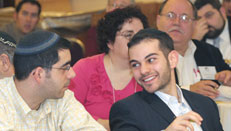 Judaism is not oblivious to the power and even importance of physical beauty. The term yefat tohar vyefot maareh (loosely translated as very attractive) or some form thereof is one we find in the Torah to describe such heroines as Sarah, Rivka, Rachel and Esther. Our Beit Mikdash - and by extension our miniature Mikdashot (better known as shuls) -had to physically reflect the fact that they represent the "dwelling place " of G-d. Their beauty must be obvious to all who enter.
"And you shall take for yourselves on the first day a pri etz hadar (fruit of the beautiful tree) an unopened palm frond, myrtle branches and willows that grow near the brook; And you shall rejoice before G-d for seven days" (Vayikra 23:40). Amazingly the Torah does not identify this beautiful fruit and it is left to the Sages of the Talmud to equate the pri etz hadar with an Etrog. In reaching this conclusion our Sages used two indicators; one based on the words pri etz and one based on the word hadar. The rabbis understood the expression pri etz to refer to a fruit whose taste is similar to that of the tree, the pri and the etz must taste alike. The Sages further understood the word hadar as referring to a fruit that lives (from the Hebrew word dar) on the tree from year to year. Unlike other fruits, which grow during the spring and summer and are harvested in the fall, the Etrog can live on the tree for many years. It appears that there is more than just linguistics involved. Our Sages are defining for us the Jewish meaning of beauty. Endurance and continuity. In the physical world and in the world as defined on Madison Avenue beauty is defined solely by appearances. In such a world beauty is short-lived. The Jewish conception of beauty is something that has permanence, something that is constant. Thus the source of the Biblical command to give respect to the elderly is phrased as "Vhadarta Pnei Zaken" (Vayikra 19:32). In Judaism beauty is associated with old age, with someone who has many years of experience and endurance.
The Etrog tree is one that gives its fruit all year round. Judaism is meant to be lived 365 days a year. The fruit of Torah - morality, dignity, holiness, sensitivity - can only be attained if Torah is a constant in our life. If one turns to Judaism only at special occasions, it will be hard to get the full enjoyment from the fruit. It might even leave a bitter taste, G-d forbid. Just as the pianist who has not practiced for months may miss too many notes and thus render the beautiful symphony unpleasant for the unlucky listeners so too one whose Judaism is not practiced on a regular, daily basis will not benefit from its full fragrance. Thus one opinion quoted by our Sages is that the most important verse in the Torah is "The first sheep should be offered in the morning and the second sheep in the afternoon" (Shmot 29:39). The daily routine of offerings each and every morning and each and every evening is the essence of a Jewish way of life.
By leading a full Jewish life on a daily basis it becomes much easier to attain the second ingredient of Jewish beauty, continuity from one generation to the next. The fruit of the Etrog must taste like the tree, just as the child must follow in the footsteps of parent. What can be more beautiful than parent and child walking together, as Torah describes by Abraham and Isaac "the two of them continued together" (Bresheet 22:8). While the personalities of Isaac and his father were radically different their value system was one and the same. This is the real meaning of Jewish beauty.
The notion of hidur mitzva, beautifying a mitzva is a concept that applies to all mitzvot. Thus, for example we make kiddush in a silver cup as opposed to paper. As we lift the Etrog let us remember that the true hidur mitzva is when mitzvot adorn us all year round and we are able to inspire others to join us in our beautiful way of life. Chag Sameach!
|








